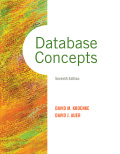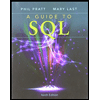
EBK DATABASE CONCEPTS
7th Edition
ISBN: 9780133544886
Author: AUER
Publisher: PEARSON CUSTOM PUB.(CONSIGNMENT)
expand_more
expand_more
format_list_bulleted
Concept explainers
Question
Chapter 3, Problem 3.14RQ
Program Plan Intro
SQL:
- SQL stands for “Structured Query Language”.
- The current version of SQL is “ANSI SQL – 92”.
- It contains constructs which are used to define and process
database . They are executed using DBMS-supplied command prompt. - SQL is not a
programming language. It is text-based and it is also called as data sublanguage. In order to get SQL as a complete programming language, it should be included in scripting languages like Java, C#, and so on.
DROP TABLE statement:
“DROP TABLE” statement comes under Data Definition Language. It is used to delete the information and to delete the structure of the table. The syntax to drop a table is as follows.
Syntax:
DROP TABLE table_Name;
Expert Solution & Answer
Want to see the full answer?
Check out a sample textbook solution
Students have asked these similar questions
Write the SQL code that permits to implement the tables: Student and Transcript. NB: Add the constraints on the attributes – keys and other.
Draw an ERD that will involve the entity types: Professor, Student, Department and Course. Be sure to add relationship types, key attributes, attributes and multiplicity on the ERD.
Draw an ERD that represents a book in a library system. Be sure to add relationship types, key attributes, attributes and multiplicity on the ERD.
Chapter 3 Solutions
EBK DATABASE CONCEPTS
Ch. 3 - Prob. 3.1RQCh. 3 - What is a data sublanguage?Ch. 3 - Prob. 3.3RQCh. 3 - Prob. 3.4RQCh. 3 - Prob. 3.5RQCh. 3 - Why do some standard SQL-92 statements fail to run...Ch. 3 - Use the following tables for your answers to...Ch. 3 - Write an SQL CREATE TABLE statement to create the...Ch. 3 - Prob. 3.9RQCh. 3 - Prob. 3.10RQ
Ch. 3 - Prob. 3.11RQCh. 3 - Is PET or PET_2 a better design? Explain your...Ch. 3 - Prob. 3.13RQCh. 3 - Prob. 3.14RQCh. 3 - Prob. 3.15RQCh. 3 - Prob. 3.16RQCh. 3 - Prob. 3.17RQCh. 3 - Write an SQL statement to display the breed, type,...Ch. 3 - Prob. 3.19RQCh. 3 - Prob. 3.20RQCh. 3 - Write an SQL statement to display the breed, type,...Ch. 3 - Write an SQL statement to display the name, breed,...Ch. 3 - Prob. 3.23RQCh. 3 - Prob. 3.24RQCh. 3 - Prob. 3.25RQCh. 3 - Write an SQL statement to display the name and...Ch. 3 - Prob. 3.27RQCh. 3 - Write an SQL statement to count the number of...Ch. 3 - Write an SQL statement to count the number of...Ch. 3 - Prob. 3.30RQCh. 3 - Prob. 3.31RQCh. 3 - Prob. 3.32RQCh. 3 - Prob. 3.33RQCh. 3 - Answer question 3.33, but do not consider any pet...Ch. 3 - Write an SQL statement to display the last name,...Ch. 3 - Write an SQL statement to display the last name,...Ch. 3 - Write SQL statements to (1) create the BREED...Ch. 3 - Prob. 3.38RQCh. 3 - Prob. 3.39RQCh. 3 - Prob. 3.40RQCh. 3 - Write an SQL statement to display the...Ch. 3 - Write SQL statements to add three new rows to the...Ch. 3 - Write SQL statements to add three new rows to the...Ch. 3 - Prob. 3.44RQCh. 3 - Explain what will happen if you leave the WHERE...Ch. 3 - Prob. 3.46RQCh. 3 - Prob. 3.47RQCh. 3 - Prob. 3.48RQ
Knowledge Booster
Learn more about
Need a deep-dive on the concept behind this application? Look no further. Learn more about this topic, computer-engineering and related others by exploring similar questions and additional content below.Similar questions
- 2:21 m Ο 21% AlmaNet WE ARE HIRING Experienced Freshers Salesforce Platform Developer APPLY NOW SEND YOUR CV: Email: hr.almanet@gmail.com Contact: +91 6264643660 Visit: www.almanet.in Locations: India, USA, UK, Vietnam (Remote & Hybrid Options Available)arrow_forwardProvide a detailed explanation of the architecture on the diagramarrow_forwardhello please explain the architecture in the diagram below. thanks youarrow_forward
- Complete the JavaScript function addPixels () to calculate the sum of pixelAmount and the given element's cssProperty value, and return the new "px" value. Ex: If helloElem's width is 150px, then calling addPixels (hello Elem, "width", 50) should return 150px + 50px = "200px". SHOW EXPECTED HTML JavaScript 1 function addPixels (element, cssProperty, pixelAmount) { 2 3 /* Your solution goes here *1 4 } 5 6 const helloElem = document.querySelector("# helloMessage"); 7 const newVal = addPixels (helloElem, "width", 50); 8 helloElem.style.setProperty("width", newVal); [arrow_forwardSolve in MATLABarrow_forwardHello please look at the attached picture. I need an detailed explanation of the architecturearrow_forward
- Information Security Risk and Vulnerability Assessment 1- Which TCP/IP protocol is used to convert the IP address to the Mac address? Explain 2-What popular switch feature allows you to create communication boundaries between systems connected to the switch3- what types of vulnerability directly related to the programmer of the software?4- Who ensures the entity implements appropriate security controls to protect an asset? Please do not use AI and add refrencearrow_forwardFind the voltage V0 across the 4K resistor using the mesh method or nodal analysis. Note: I have already simulated it and the value it should give is -1.714Varrow_forwardResolver por superposicionarrow_forward
- Describe three (3) Multiplexing techniques common for fiber optic linksarrow_forwardCould you help me to know features of the following concepts: - commercial CA - memory integrity - WMI filterarrow_forwardBriefly describe the issues involved in using ATM technology in Local Area Networksarrow_forward
arrow_back_ios
SEE MORE QUESTIONS
arrow_forward_ios
Recommended textbooks for you

 A Guide to SQLComputer ScienceISBN:9781111527273Author:Philip J. PrattPublisher:Course Technology Ptr
A Guide to SQLComputer ScienceISBN:9781111527273Author:Philip J. PrattPublisher:Course Technology Ptr Programming with Microsoft Visual Basic 2017Computer ScienceISBN:9781337102124Author:Diane ZakPublisher:Cengage Learning
Programming with Microsoft Visual Basic 2017Computer ScienceISBN:9781337102124Author:Diane ZakPublisher:Cengage Learning Enhanced Discovering Computers 2017 (Shelly Cashm...Computer ScienceISBN:9781305657458Author:Misty E. Vermaat, Susan L. Sebok, Steven M. Freund, Mark Frydenberg, Jennifer T. CampbellPublisher:Cengage Learning
Enhanced Discovering Computers 2017 (Shelly Cashm...Computer ScienceISBN:9781305657458Author:Misty E. Vermaat, Susan L. Sebok, Steven M. Freund, Mark Frydenberg, Jennifer T. CampbellPublisher:Cengage Learning Database Systems: Design, Implementation, & Manag...Computer ScienceISBN:9781285196145Author:Steven, Steven Morris, Carlos Coronel, Carlos, Coronel, Carlos; Morris, Carlos Coronel and Steven Morris, Carlos Coronel; Steven Morris, Steven Morris; Carlos CoronelPublisher:Cengage Learning
Database Systems: Design, Implementation, & Manag...Computer ScienceISBN:9781285196145Author:Steven, Steven Morris, Carlos Coronel, Carlos, Coronel, Carlos; Morris, Carlos Coronel and Steven Morris, Carlos Coronel; Steven Morris, Steven Morris; Carlos CoronelPublisher:Cengage Learning Database Systems: Design, Implementation, & Manag...Computer ScienceISBN:9781305627482Author:Carlos Coronel, Steven MorrisPublisher:Cengage Learning
Database Systems: Design, Implementation, & Manag...Computer ScienceISBN:9781305627482Author:Carlos Coronel, Steven MorrisPublisher:Cengage Learning


A Guide to SQL
Computer Science
ISBN:9781111527273
Author:Philip J. Pratt
Publisher:Course Technology Ptr

Programming with Microsoft Visual Basic 2017
Computer Science
ISBN:9781337102124
Author:Diane Zak
Publisher:Cengage Learning

Enhanced Discovering Computers 2017 (Shelly Cashm...
Computer Science
ISBN:9781305657458
Author:Misty E. Vermaat, Susan L. Sebok, Steven M. Freund, Mark Frydenberg, Jennifer T. Campbell
Publisher:Cengage Learning

Database Systems: Design, Implementation, & Manag...
Computer Science
ISBN:9781285196145
Author:Steven, Steven Morris, Carlos Coronel, Carlos, Coronel, Carlos; Morris, Carlos Coronel and Steven Morris, Carlos Coronel; Steven Morris, Steven Morris; Carlos Coronel
Publisher:Cengage Learning

Database Systems: Design, Implementation, & Manag...
Computer Science
ISBN:9781305627482
Author:Carlos Coronel, Steven Morris
Publisher:Cengage Learning